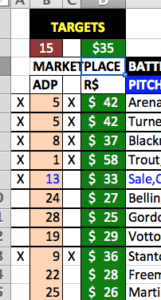BABS Master Spreadsheet
New to BABS? Please review this tutorial before using the spreadsheet. For a complete discussion of what the BABS system is all about, please read the FREE eBook, “The BABS Project 3.1”
Why we need a new system | The Broad Assessment Balance Sheet (BABS) | BABS in practice
TARGET columns allow you to set your own custom player targets at any stage of your draft. Enter a value in either of the maroon (for snake drafts) or green (for auctions) fields, and an “X” will appear next to the name of the players who should be flagged as targets.
For snake drafts
 In the early stages of the draft, enter the number of your upcoming pick to see which players will most likely be gone by the time your pick comes to you. You can also enter the number of your pick a round ahead to see which players you need to grab in order to avoid losing out on them.
In the early stages of the draft, enter the number of your upcoming pick to see which players will most likely be gone by the time your pick comes to you. You can also enter the number of your pick a round ahead to see which players you need to grab in order to avoid losing out on them.
For instance, if you have the first pick in a 15-team draft, after you choose Trea Turner, enter 30 in the target field (that’s your next pick), and all the players likely to be gone by your next pick will be flagged. If any are still available once your pick arrives, that would be a possible target (if BABS agrees). You can enter 60 to see which players you need to consider drafting at 30 and 31 in order to avoid missing out on them.
Whatever target number you select, the resulting “X”s that appear constitute the player ranking you should be drafting from. Un-“X”ed players will continue to bubble up to the top; they are the better-skilled players who you can wait on until they begin to approach their market value. As you update your target range, those players will eventually get “X”ed and that is when you can start considering them.
As you get further into your draft, you will need to expand your target range. You might consider entering a pick number that’s 2-3 rounds ahead in order to cover the real range in which players might be selected. By round 16 or so, the ADPs are almost meaningless and have such a wide range of error that you will need to enter a value perhaps 5-6 rounds ahead.
For auctions
Use the target field to keep track of available players at each dollar value range. For instance, if you enter $20, the spreadsheet will flag the remaining players who will likely be purchased for $20 or more. The BABS rankings tells you which are the best buys at that price point.
In the end game, enter $1, and the spreadsheet will flag all the remaining players who will likely be purchased by the other owners. BABS might have a few surprises for un-X’ed players with the potential for positive earnings.
Other stuff
Full-timers, Mid-timers and Part-timers are included together within each asset group. BABS does this so you can see which players might have some upside and downside, but be aware of the indicators when drafting. “F” players should almost always get preference over “M” players when a choice has to made, and “M” over “P”, unless you are choosing between a markedly poorer full-timer over a higher-skilled mid-timer.
No-timers appear separately further down the chart.
